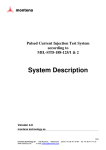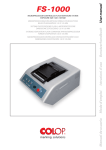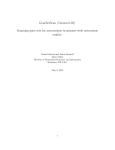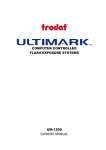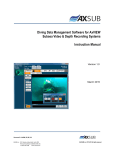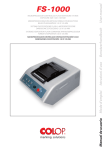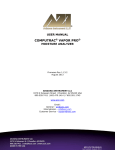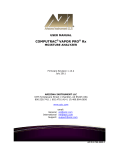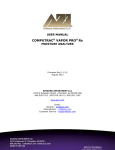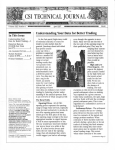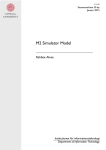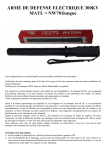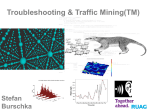Download System Description
Transcript
Pulsed Current Injection Test System according to MIL-STD-188-125/1 & 2 System Description Version 1.0 Montena EMC 1/30 montena emc sa CH-1728 Rossens – phone ++41 (0)26 411 93 33 – fax ++41(0)26 411 93 30 - http://www.emc.montena.com Table of content 1. 1.1 1.2 1.3 2. 3. 3.1 3.2 3.3 4. 4.1 4.2 4.3 5. 5.1 5.2 5.3 6. 7. 8. Montena emc ................................................................................................................................ 3 PRODUCTS ................................................................................................................................................... 3 NEMP TEST SYSTEMS REFERENCES ............................................................................................................... 4 OTHER MIL-STD REFERENCES ...................................................................................................................... 6 PCI test system description ........................................................................................................ 7 Pulse generators and control units ........................................................................................... 8 SHORT PULSE GENERATORS & CONTROL UNITS ................................................................................................ 8 INTERMEDIATE PULSE GENERATOR & CONTROL UNIT ....................................................................................... 12 CHARGE LINE PULSER.................................................................................................................................. 13 Pulse coupling devices ............................................................................................................. 14 COUPLING OF THE SHORT PULSE .................................................................................................................. 14 COUPLING OF THE INTERMEDIATE PULSE ....................................................................................................... 15 COUPLING OF THE CHARGED LINE PULSE ....................................................................................................... 15 Isolating devices ........................................................................................................................ 16 DECOUPLING OF THE SHORT PULSE............................................................................................................... 16 DECOUPLING OF THE INTERMEDIATE PULSE.................................................................................................... 17 DECOUPLING OF THE CHARGED LINE PULSE ................................................................................................... 17 Termination loads ...................................................................................................................... 18 System monitoring .................................................................................................................... 19 Control and data acquisition system ....................................................................................... 20 8.1 8.2 PC, GPIB INTERFACE & PRINTER ................................................................................................................. 20 DATA ACQUISITION SOFTWARE ..................................................................................................................... 21 9. 10. Shielded container ..................................................................................................................... 23 Universal instruments ............................................................................................................... 25 10.1 10.2 11. 12. 13. 13.1 13.2 13.3 13.4 13.5 13.6 DUMMY LOADS............................................................................................................................................ 25 OTHER INSTRUMENTS & ACCESSORIES.......................................................................................................... 25 Electric POE protective devices ............................................................................................... 26 PCI simulation software ............................................................................................................ 27 Services & Support .................................................................................................................... 29 MANUALS AND DOCUMENTATION ................................................................................................................... 29 ONSITE INSTALLATION AND TRAINING............................................................................................................. 29 SYSTEM ACCEPTANCE ................................................................................................................................. 29 MAINTENANCE ............................................................................................................................................ 30 TECHNICAL ASSISTANCE .............................................................................................................................. 30 WARRANTY ................................................................................................................................................ 30 Version 1.0 / 11.08.2008 V:\Marketing\Prospectus_produits\SystemDescriptionDocuments\PCI_Tests_System_Description.doc 2/30 montena emc sa CH-1728 Rossens – phone ++41 (0)26 411 93 33 – fax ++41(0)26 411 93 30 - http://www.emc.montena.com 1. Montena emc Since its foundation in 1978, montena emc has earned a worldwide reputation for its leading-edge skills in the fields of high voltage, high frequency and electromagnetic fields. Montena emc is number one EMC test lab in Switzerland, with a team of 35 people (23 engineers). With two large anechoic chambers, an open area test site and multiple shielded rooms, montena can test and validate all kinds of equipment. Figure 1 : Montena emc headquarters - helicopter in one of montena's anechoic chamber Montena emc laboratory is accredited by SAS (Swiss Accreditation Service) for the calibration of EMC measuring devices as well as for the verification of the electrical safety of equipment and devices according to European Union directives and to Swiss legislation. Montena can count on highly specialized specialised know-how in the field of electromagnetic compatibility. These skills are put to good use in our EMC laboratories as well as in the development and construction of various kinds of equipment. In the field of high voltage and high frequencies, montena's engineers are masters of the techniques used to generate rapid pulses with fast rise time, including those to endow them with special characteristics. 1.1 Products Montena emc designs, builds and markets equipment and accessories for EMC tests. The range of products includes antennas, TEM cells, striplines, field sensors, all kind of pulse generators, test benches, etc. Montena's high voltage pulse generators are mainly used for EMC tests, ultra-rapid imaging and pulsed light decontamination. Montena also builds pulse generators according the custom specific needs. 3/30 montena emc sa CH-1728 Rossens – phone ++41 (0)26 411 93 33 – fax ++41(0)26 411 93 30 - http://www.emc.montena.com Figure 2 : some montena emc products 1.2 NEMP test systems references In the past years montena has designed, build and delivered many test installations for both conducted and radiated susceptibility NEMP tests. The list below shows typical examples of delivered test installations. NEMP test generator 75 kV 2.8/25 ns with control unit NEMP test generator 320 kV 2.8/25 ns with control unit NEMP test generator 12kV 5/200 ns 4/30 montena emc sa CH-1728 Rossens – phone ++41 (0)26 411 93 33 – fax ++41(0)26 411 93 30 - http://www.emc.montena.com NEMP test generator 75 kV 2.8/25 ns with radiation line 1.8 m high for test according to MIL 461E RS105 NEMP test radiation line 12 m high NEMP test generator 120 kV 2.8/25 ns with radiation line 2.7 m high NEMP test generator 230 kV 2.8/25 ns with radiation line 3.6 m high 5/30 montena emc sa CH-1728 Rossens – phone ++41 (0)26 411 93 33 – fax ++41(0)26 411 93 30 - http://www.emc.montena.com 1.3 Other MIL-STD references Montena has developed and sold turnkey test setups for other MIL-STD 461 test systems as RS 101, CS 101, CS 114, CS 115 and CS 116. Figure 3 : CS116 & CS115 test setup from montena 6/30 montena emc sa CH-1728 Rossens – phone ++41 (0)26 411 93 33 – fax ++41(0)26 411 93 30 - http://www.emc.montena.com 2. PCI test system description Montena's EMP PCI test system is design to perform Pulsed Current Injection tests according MILSTD 188-125-1 & 2. The test setup comprises following elements. Figure 4 : Schematic of a typical PCI test setup installation The pulse penerators deliver the high energy pulses either directly or through coupling devices in the cable under test. The pulse enters the facility under test through the point of entry protective devices. An oscilloscope collects the measurements from the current and voltage sensors for display and eventually storage in the control PC. In order to ensure correct measurement the sensors are connected using fibre optic links. The measurement and control systems are installed in a shielded measurement container. When not used, all the test equipment can be stored in the transportable shielded measurement container. Pulse shapes Montena's PCI test system, is able to perform pulsed current injection tests according MIL-STD 188125-1 & 2, except for the long pulse. Short pulse Intermediate pulse Charge line pulse Max. short circuit current (Isc) ≥ 5,000 Amp ≥ 250 Amp ≥ 400 Amp Adjustable range of Isc ≤ 100 to ≥ 5,000 Amp ≤ 25 to ≥ 250 Amp ≤ 10 to ≥400 Amp Waveform Double exponential Double exponential Variable pulse width Rise time (10%~90%) ≤ 20 ns ≤ 1.5 µs ≤ 5 ns FWHM (50%~50%) 500 .. 550 ns 3 .. 5 ms variable Source impedance ≥ 60 Ω ≥ 10 Ω ≥ 50 Ω 7/30 montena emc sa CH-1728 Rossens – phone ++41 (0)26 411 93 33 – fax ++41(0)26 411 93 30 - http://www.emc.montena.com 3. Pulse generators and control units The test system comprises four pulse generators designed and built by Montena. The generators can be directly controlled and remotely controlled via a PC. 3.1 Short pulse generators & control units To fulfil the test specifications (>5000A with 60 Ohm), the short pulse generator has to deliver up to 300 kV. Additionally, to be able to test different type of POE protecting devices, it should be possible to perform tests at lower voltage (some tens of kV). As it is not possible to design a Marx generator for the required voltage range (10 kV– 300 kV), two generators are proposed: • A 80kV direct discharge pulse generator (10kV – 80 kV) • A 300kV high voltage Marx generator (~100 kV – 300 kV) The output impedance of the short pulse generator is a few Ohms only. It is then possible to generate the required 5 kA without having to deliver a very high voltage. Only in the case where the high voltage is desired (for instance to test high and middle voltage points of entry of building or installations, where the high voltage is required to eventually reach an isolation breakdown) the 300kV short pulse generator is required. As this generator is quite expensive, it is usually proposed as option and is separately priced. The short pulse generators are delivered with a 60 Ohm dumy load. This load is intended for either: • Terminate a cable under test with a load supporting the high voltage pulse. • Calibrate the pulse generator with a load supporting the high voltage pulse. • Increase the output impedance of the pulse generator to the required 60 Ohms. Direct Discharge 80kV Short Pulse Generator This generator is built around one stage of high voltage capacitors directly charged from a high voltage power supply. The system comprises the high voltage unit and the control unit. High voltage unit Control unit of the generator Figure 5 : Picture of a similar >75kV direct discharge generator 8/30 montena emc sa CH-1728 Rossens – phone ++41 (0)26 411 93 33 – fax ++41(0)26 411 93 30 - http://www.emc.montena.com Preliminary specifications of the short pulse 80kV direct discharge generator Standard MIL-STD-188-125-1&2 Type direct capacitor discharge Peak open circuit voltage 10 kV to 80 kV, positive only Peak short circuit current 5 kA Source impedance 60 ohm (with external resistors) Pulse shape double exponential waveform Rise time of the current (short circuit) < 20 ns Pulse length (FWHM) of the current (short circuit) 500 - 550 ns Rise time of the voltage (open circuit) < 20 ns Pulse length of the voltage (open circuit) defined by the load connected to the output Loading time <1 min Output connectors proprietary Triggering of the generator manually or by the remote control Interface RS 232 Power rating 210 - 250 Vac / 50 - 60 Hz / 150 W Safety complies with EN61010-1. Safety circuit loop 24 Vdc / 500 mAmax EMC complies with EN 61326-1 Storage / working temperature 5 - 50 °C/ 20 - 40 °C Dimensions (control unit) 42 x 53 x 15 mm (D x W x H) Dimensions (generator) 600 x 260 x 240 mm (L x W x H) Generator weight 50 kg (with oil) 9/30 montena emc sa CH-1728 Rossens – phone ++41 (0)26 411 93 33 – fax ++41(0)26 411 93 30 - http://www.emc.montena.com Marx 300 kV Short Pulse Generator This generator is built around a Marx generator delivering up to 300 kV in open circuit and more than 5 kA in short circuit. It comprises the high voltage Marx unit and the control unit. High voltage unit Control unit of the generator Figure 6 : Picture of a similar >300kV Marx generator 10/30 montena emc sa CH-1728 Rossens – phone ++41 (0)26 411 93 33 – fax ++41(0)26 411 93 30 - http://www.emc.montena.com Preliminary specifications of the short pulse Marx 300kV generator Standard MIL-STD-188-125-1&2 Type Marx Peak open circuit voltage ~100kV to 300 kV, positive only Peak short circuit current 5 kA Source impedance 60 ohm (with external resistors) Pulse shape double exponential waveform Rise time of the current (short circuit) < 20 ns Pulse length (FWHM) of the current (short circuit) 500 - 550 ns Rise time of the voltage (open circuit) < 20 ns Pulse length of the voltage (open circuit) defined by the load connected to the output Energy @ 300 kV 590 J Loading time <1 min Output connectors proprietary Triggering of the generator manually or by the remote control Interface RS 232 Power rating 210 - 250 Vac / 50 - 60 Hz / 500 W / 1 phase Safety complies with EN61010-1. Safety circuit loop 24 Vdc / 500 mAmax EMC complies with EN 61326-1 Dimensions (control unit) about 44 x 53 x 35 mm (D x W x H) Dimensions (generator) about 1.2 x 0.5 x 0.5 m. (l x w x h) Storage / working temperature 5 - 50 °C/ 20 - 40 °C Environment inside use; outside use only by good weather and protected from the direct sunshine 11/30 montena emc sa CH-1728 Rossens – phone ++41 (0)26 411 93 33 – fax ++41(0)26 411 93 30 - http://www.emc.montena.com 3.2 Intermediate pulse generator & control unit This generator is built using a direct discharge of high voltage capacitors. Figure 7 : Picture of a similar pulse generator based on the same technology Preliminary specifications of the intermediate pulse generator Standard MIL-STD-188-125-1&2 Type direct capacitor discharge Peak open circuit voltage 0.2 kV to 2.5 kV, positive only Peak short circuit current 250 A Source impedance 10 ohm Pulse shape double exponential waveform Rise time of the current (short circuit) < 1.5 us Pulse length (FWHM) of the current (short circuit) 4 ms Rise time of the voltage (open circuit) < 1.5 us Pulse length of the voltage (open circuit) defined by the load connected to the output Energy @ 2.5 kV 1.75 kJ Loading time <1 min Output connectors HV Lemo or similar Triggering of the generator manually or by the remote control Interface RS 232 Power rating 210 - 250 Vac / 50 - 60 Hz / 500 W EMC complies with EN 61326-1 Safety complies with EN61010-1. Safety circuit loop 24 Vdc / 500 mAmax Storage / working temperature 5 - 50 °C / 15 - 45 °C Environment inside use; outside use only by good weather 12/30 montena emc sa CH-1728 Rossens – phone ++41 (0)26 411 93 33 – fax ++41(0)26 411 93 30 - http://www.emc.montena.com 3.3 Charge line pulser This generator is based on a variable charge line. In order to adjust the length of the charge line to the quarter-wavelength of the applicable frequency, special coaxial cables must be connected to the pulse generator (on the rear side). A set of 9 cables are supplied with the generator to cover the frequency range of 30 to 300 MHz. Figure 8 : Picture of a similar pulse generator Preliminary specifications of the charge line pulser Standard MIL-STD-188-125-2 Type charged line Peak open circuit voltage 0.2 kV - 40 kV, positive only Peak short circuit current > 400 A Source impedance 50 ohm Pulse shape, on 50 ohm rectangular waveform Rise time of the current, on 50 ohm < 5 ns Pulse length (FWHM) of the current, on 50 ohm selectable with cables for resonance frequencies at 30, 40, 50, 75, 100, 150, 200, 250 and 300 MHz Energy depends on the length of the pulse Loading time <30 sec Output connectors HV Lemo or similar Triggering of the generator manually or by the remote control Interface RS 232 Power rating 210 - 250 Vac / 50 - 60 Hz / 300 W EMC complies with EN 61326-1 Safety complies with EN61010-1 Storage / working temperature 5 - 50 °C / 15 - 45 °C Environment inside use; outside use only by good weather 13/30 montena emc sa CH-1728 Rossens – phone ++41 (0)26 411 93 33 – fax ++41(0)26 411 93 30 - http://www.emc.montena.com 4. Pulse coupling devices The PCI test system is designed to allow the injection of the different types of pulses on 3 typical types of cables / connexions: • shielded cables • mains AC / DC supply, 2 wires, 50 A, 230 Vac or 60 Vdc • signal / data / telecom cables, 4 wires, 1 A, 60 Vdc. The coupling can be inductive or capacitive or direct. 4.1 Coupling of the short pulse Due to the high voltage of the short pulse generator and the rather long duration of the pulse, the capacitive coupling requires a capacitor having a high capacitance and large dimensions. The direct coupling can be used on shielded cables and similar metallic connection penetrating inside the protected area. A) Inductive coupling The specifications of the inductive coupler are the following. Figure 9 : Picture of the inductive coupler Specifications of the short pulse inductive coupler Frequency range 500 kHz - 30 MHz Maximum peak voltage (1/500 ns) typ. 50 kV / max 100 kV Maximum peak current ≥ 5 kA Max. diameter of the tested cable about 100 mm Connector proprietary Weight 60 kg Dimensions (mm) 630 x 220 x 270 14/30 montena emc sa CH-1728 Rossens – phone ++41 (0)26 411 93 33 – fax ++41(0)26 411 93 30 - http://www.emc.montena.com B) Capacitive coupling The capacitive coupling is combined with the isolating network in a same cabinet. Therefore please see the chapter 5.1 Decoupling of the short pulse. 4.2 Coupling of the intermediate pulse Because of the low frequency content of the intermediate pulse neither capacitive nor inductive coupling is possible. This is due to the very high capacitance / inductance required for the coupling efficiency. In addition these very high capacitance / inductance will drain high current from the device or from the source connected to the line under test. Therefore the methods of coupling will be the following: • On shielded cables: direct connection to the generator. • On mains AC / DC supply connections: direct coupling to the pulse generator. The mains source or the auxiliary test equipment must be powered through an isolating transformer in order to force the current of the pulse to flow in the protective device. In this way, the "external load" is isolated. The intermediate pulse generator will be equipped with 4 independent outputs which will allow the coupling on 4 lines. The pulse will be injected on 1 (wire-to-ground) or 2, 3 or 4 lines (common mode). • On signal / data / telecom cables 1 A / 4 wires / 60 Vdc / 1 A. Like already explained above, capacitive / inductive coupling cannot be used therefore a direct coupling will be carried out through the 4 outputs of the generator. A transformer could also be used to isolate the connected equipment from the external world. Summary: we recommend to use direct coupling. No specific coupling device is proposed. Eventually a A 60 A / 230 Vac isolating transformer could be proposed as an option. 4.3 Coupling of the charged line pulse The coupling of the charged line pulse will be carried out by direct connection of the coaxial cable / connection to test to the pulse generator. Summary: No coupling device is proposed. 15/30 montena emc sa CH-1728 Rossens – phone ++41 (0)26 411 93 33 – fax ++41(0)26 411 93 30 - http://www.emc.montena.com 5. Isolating devices The purpose of these decoupling devices is to isolate the "external load" (= the mains, the auxiliary equipment, etc.) from the pulses injected by the generators. Unfortunately using isolating devices is not always possible due to the fact that these devices can also block the signal if their frequency is in the same range than the pulse. So we recommend generally to inject the pulses only on lines and connection which are not connected to active auxiliary equipment. 5.1 Decoupling of the short pulse Due to the high voltage of the short pulse generator, the decoupling requires capacitors and inductances of large dimensions. In addition, the rather high value of the decoupling components will exhibit a low pass filter behaviour not compatible with most of the ordinary signals. Therefore the isolating device cannot be used in some cases. Other coupling / isolating methods must be used in these cases. The proposed isolating device includes the capacitive coupling in one cabinet. The specifications of the isolating / capacitive coupler are the following: A) Isolating / capacitive coupler for the mains supply Nominal voltage (50 / 60 Hz / DC) 230 Vac or 60 Vdc Nominal voltage (400 Hz) 110 Vac Nominal current (50 / 60 / 400 Hz / DC) 60 A Number of lines 2 Maximum pulse peak voltage (1/500 ns) typ. 13 kV / max 15 kV Maximum pulse peak current ≥ 5 kA Signal cut-off frequency (- 3 dB) 10 kHz Connector proprietary Weight 120 kg Dimensions (mm) 600 x 760 x 380 16/30 montena emc sa CH-1728 Rossens – phone ++41 (0)26 411 93 33 – fax ++41(0)26 411 93 30 - http://www.emc.montena.com B) Isolating / capacitive coupler for the signal / data / telecom Nominal voltage (50 / 60 Hz / DC) 230 Vac or 60 Vdc Nominal voltage (400 Hz) 110 Vac Nominal current (50 / 60 / 400 Hz / DC) 1A Number of lines 4 Maximum pulse peak voltage (1/500 ns) typ. 13 kV / max 15 kV Maximum pulse peak current ≥ 5 kA Signal cut-off frequency (- 3 dB) 10 kHz Connector proprietary Weight 100 kg Dimensions (mm) 600 x 760 x 380 5.2 Decoupling of the intermediate pulse Because the frequency content of the pulse is the range of some Hz to some kHz, it is not possible to use isolating devices. The signals and even the mains 50 / 60 Hz will be blocked by the decoupling devices. Finally the size, weight and price of these devices will be prohibitive. 5.3 Decoupling of the charged line pulse Because the pulse is injected directly on the coaxial connection, isolating devices are neither possible nor needed. 17/30 montena emc sa CH-1728 Rossens – phone ++41 (0)26 411 93 33 – fax ++41(0)26 411 93 30 - http://www.emc.montena.com 6. Termination loads A set of 2, 50 and 300 ohm termination loads are usually proposed as option. These loads can be connected to the end of the tested lines, inside or/and outside the protected area to terminate the line and absorb the injected current pulse. They are not applicable to the AC / DC supply. The termination loads consist of a box containing 4 resistors for 4 independent lines. The specifications are the following: Maximum peak voltage 25 kV Maximum energy 1.8 kJ Number of channels (= number of resistors per box) 4 Resistance 2 or 50 or 300 ohm Connector proprietary The set of termination load consists of: • 2 boxes (+ 1 spare) of 4 resistors of 2 ohm for signal / data / telecom; • 2 boxes (+ 1 spare) of 4 resistors of 50 ohm for signal / data / telecom; • 2 boxes (+ 1 spare) of 4 resistors of 300 ohm for signal / data / telecom. 18/30 montena emc sa CH-1728 Rossens – phone ++41 (0)26 411 93 33 – fax ++41(0)26 411 93 30 - http://www.emc.montena.com 7. System monitoring The test monitoring comprises current and voltage sensors, an oscilloscope and a PC with its software for automatic control, data acquisition and automatic report generation. Current sensors Required are two current sensors: one measuring the injected current and one for the residual current. Residual voltage sensor In order to have a good measurement sensitivity, two residual voltage sensors are proposed: A 1000x probe and a 100x probe. Optical link transmission For reliable measurement, the transmission has to be immune to the generated field. A fibre optic link is then used for each sensor. The proposed optical transmission comprises 4 links: • 3 x Acquisition Module 1 kHz ÷ 1 GHz (50 Ohm) • 1 x Acquisition Module 6Hz ÷ 15MHz (1MOhm) Digital Oscilloscope The proposed oscilloscope has following characteristics: • 4 channels digital oscilloscope • 2 GHz bandwidth • 5 Gs/s (10Gs/s max) 19/30 montena emc sa CH-1728 Rossens – phone ++41 (0)26 411 93 33 – fax ++41(0)26 411 93 30 - http://www.emc.montena.com 8. Control and data acquisition system 8.1 PC, GPIB interface & printer The proposed system comprises: • • • One DELL pc • Intel Core2 Duo processor 2.4 GHz • Windows XP professional or Vista Business • 160 GB hard drive • 22" monitor (1680 x 1050) One color laser printer • A4 color printer • 600 x 600 dpi • Up to 12 pages per minutes (16 monochrome) One GPIB PCI card model for the Desktop computer 20/30 montena emc sa CH-1728 Rossens – phone ++41 (0)26 411 93 33 – fax ++41(0)26 411 93 30 - http://www.emc.montena.com 8.2 Data acquisition software This software is developed by montena with Labview, specifically for this test setup. Figure 10 : Example of Montena's LabView based program (here a CS116 calibration panel) Figure 11 : Example of a automatically generated test report 21/30 montena emc sa CH-1728 Rossens – phone ++41 (0)26 411 93 33 – fax ++41(0)26 411 93 30 - http://www.emc.montena.com The proposed software will be built with the existing basic blocks developed by montena to control the generators and the measurement equipments, to collect measured data, and to process the data for display and automatic report generation. The software contains calibration panels to set the correction factors of sensors and transmission links. The software will be designed according to the specific needs of the PCI test system operation and will be presented to the end customer for approval before its final implementation. Montena delivers the software as well as the source code. the end customer has then the possibility to extend / modify this software according their future needs. Of course montena can also be mandated for these eventually future adaptations. 22/30 montena emc sa CH-1728 Rossens – phone ++41 (0)26 411 93 33 – fax ++41(0)26 411 93 30 - http://www.emc.montena.com 9. Shielded container The proposed shielded container is provided by RUAG. RUAG Land Systems Ltd. Allmendstrasse 86 3602 Thun Switzerland Phone +41 332 282 111 Fax +41 332 284 783 [email protected] www.ruag.ch RUAG is a Swiss company active in the Aviation & space, Defense & security and in Ammunition. Since decades RUAG delivers NEMP shielded containers for civil protection and military applications. The container is a standard (8 ft x 8 ft x 20ft) transportable container as shown in the picture below. Figure 12 : Typical NEMP container from RUAG The container has the following equipment • Walls and ceiling are made of steel • Door without window • Wooden floor with non-slip and abrasion resistant vinyl flooring • Under floor protection (outside) • Electrical installations (5 x double 230V and 5 x RJ45 – for 5 working places) • Air conditioning (4.5 kW) • External power supply through lightning protection box and insulating transformer 230V/35A • Coaxial feed through connector • Optical fibre cable entry • Standard locking system and is delivered with following furniture: • 1 x 19" rack 600 x 700 x 1800 mm • 1 x table for 5 working places with 5 x chairs • 1 x 3 drawers file cabinet 23/30 montena emc sa CH-1728 Rossens – phone ++41 (0)26 411 93 33 – fax ++41(0)26 411 93 30 - http://www.emc.montena.com Figure 13 : Proposed internal furniture It remains always possible to define the exact internal configuration during the execution of the project. 24/30 montena emc sa CH-1728 Rossens – phone ++41 (0)26 411 93 33 – fax ++41(0)26 411 93 30 - http://www.emc.montena.com 10. Universal instruments 10.1 Dummy loads The dummy loads are to be used with the pulse generators as • serial resistor to limit the pulse current or • termination load for measurement of the current / voltage pulse under well know conditions. Following termination loads are offered: • 1 x 60 Ohm termination load 300kV 600J (included with 300kV short pulse generator delivery) • 1 x 60 Ohm termination load 80kV 200J (included with 80kV short pulse generator delivery) • 1 x 10 Ohm termination load 10 Ohm, 1800J • 1 x 50 Ohm termination load 10J 10.2 Other instruments & accessories The system is delivered with all required measurement cables and other accessories (as attenuators) to perform the test according to the test setup presented in Figure 4 : Schematic of a typical PCI test setup installation of this document. Additional cables, attenuators and optical fibres are proposed as spare parts. 25/30 montena emc sa CH-1728 Rossens – phone ++41 (0)26 411 93 33 – fax ++41(0)26 411 93 30 - http://www.emc.montena.com 11. Electric POE protective devices A set of NEMP filters is offered to perform FAT, SAT and other types of calibration or reference tests. AC power line filters One NEMP AC power line filter for 4 lines (3L + 1N) 400/230V, 50/60Hz for up to 40Amp. DC power line filters 2 (two) x NEMP DC power line filters for a DC powering up to 30V DC / 10A. Data line filters 4 (two) x NEMP fast data protectors - (up to 155 MBit/s) (For a single Ethernet 10/100 MBit/s application two (2) protectors are necessary - one protector for one wire pair). Digital telephony line filters 2 (two) x NEMP low to medium data rate protectors - (up to 2MBit/s). VHF test filters 2 (two) x NEMP VHF antennas lines filter - (DC – 1000 MHz). 26/30 montena emc sa CH-1728 Rossens – phone ++41 (0)26 411 93 33 – fax ++41(0)26 411 93 30 - http://www.emc.montena.com 12. PCI simulation software In order to estimate the protection effectiveness of systems, a simulation software is provided. It allows to perform extrapolation of the performed measurements. The solution includes more or less simple CAD (computer-aided design) tools and importation tools from most common mechanical tools (for instance Solid Works). But a full CAD might be required for the simulation of complicated structures (not included in the quotation). A good working station (windows based) and screen with a selected graphic card are proposed as an option in the quotation. The proposed package fulfils all the requirements with 2 separate softwares: • a very complete Finite-Difference Time-Domain (FDTD) simulator; • an integrated circuit editor and simulator. The global method of working is 1) to use the FDTD to calculate the electromagnetic field distribution in the space, the coupling inside structures, like shielded cables and enclosures and to calculate the induced current and voltage; and 2) to use the circuit simulator to calculate the effect of protective devices (non-linear circuits included), the current and voltage on electric / electronic circuits, etc. Remark: the selected FDTD simulator SEMCAD X (see below) will soon include a coupled circuit (SPICE)-EM simulator. Proposed products: 1) FDTD simulator: SEMCAD X SEMCAD X is the latest generation of 3-D FDTD & FIT (finite-integration technique) full-wave simulation software offering unprecedented levels of user-friendliness, speed & memory efficiency. Its application range has been greatly extended by, e.g., effective GA (generic algorithm) optimization of parameterised CAD derived structures and superior speed (>50x faster than others). This software is used by Montena emc for more than 2 years. It gives excellent results and is rather easy to use. The offer comprises: • 1 x SEMCAD X aXware 500 package (Windows XP professional 64 bits) • Hotline and support for 1 year • Dongle for 1 user • CD and manual • aXware FDTD hardware accelerator. No training is included in the quotation. Training courses are regularly organised. 27/30 montena emc sa CH-1728 Rossens – phone ++41 (0)26 411 93 33 – fax ++41(0)26 411 93 30 - http://www.emc.montena.com A demo version with restricted performances and library is available on the website of the company (www.semcad.com/simulation/index.php). 2) Schematic editor and simulator: Micro-Cap 9 Micro-Cap 9 is an integrated schematic editor and mixed analog/digital simulator that provides an interactive sketch and simulates environment for electronics engineers. Since its release in 1982, Micro-Cap has been steadily expanded and improved. Micro-Cap 9, the ninth generation, blends a modern, intuitive interface with robust numerical algorithms to produce unparalleled levels of simulation power and ease of use. Nothing else comes close. This software is used by Montena emc for 15 years. It is easier to use compared with PSpice, for instance and gives similar results. Micro-Cap 9 is compatible with PSpice, SPICE3, etc. In addition to the comprehensive library included in the package, SPICE models can be downloaded from the components manufacturers. The offer comprises: • 1 x Microcap 9 (Windows XP or Vista) • Dongle for 1 user • CD and manual No training is included in the quotation. Because this software is easy to use, training course are not required, in our opinion. An evaluation version is available on the website of the company (www.spectrum-soft.com). It is limited to 50 components, anywhere from 0 to 300 % slower than the professional, limited component library, no Model program, and some of the advanced features are not available. This version can be used after purchasing the full version ("one seat" version) by other persons as a viewing tool or for testing simple adjustments on circuits developed with the full version. The combined solution will have the following features: 1) HEMP interaction on cables 2) Shielded cable and transfer impedance analysis 3) Circuit simulation 4) Volume shield analysis 28/30 montena emc sa CH-1728 Rossens – phone ++41 (0)26 411 93 33 – fax ++41(0)26 411 93 30 - http://www.emc.montena.com 13. Services & Support 13.1 Manuals and documentation The provided documentation comprises: • A system level installation and user manuals (one paper copy + CD) • Installation and user manuals of each delivered equipment (CD) • An installation and user manual for the data and acquisition software (one paper copy + CD) • Source code of the data and acquisition software (CD) • Installation and user manual for the PCI simulation software (CD) 13.2 Onsite installation and training Montena emc provides worldwide onsite installation performed by montena's engineers with help of skilled and unskilled workmen provided by the customer. When required, site preparation works have to be organized by the customer in coordination with montena emc. This site preparation work must be of good quality, must fulfil montena's requirements, and must be completely finished before the beginning of the installation by montena emc. In this project, no special site preparation is required. A comprehensive training session is offered and will be given directly after installation. This training includes: • the test system installation, operation and maintenance. This training will be provided by an engineer from montena • the simulation software installation and operation. This training will be provided by an engineer from the simulation software providers, under the coordination of montena. The content of the training sessions will be defined according to the end customer desires. 13.3 System acceptance The test system acceptance procedure is performed with a verification of the generated test pulses and comprises: • A measurement of the generated current and voltage pulses • A measurement of residual current and voltage pulses behind the provided NEMP filters • A comparison with the typical specifications of the filters. The acceptance comprises two phases: • • A FAT (factory acceptance test) at Montena in Switzerland to demonstrate the system performance • One week for 2 people from the end customer • Travel and lodging are at the end customer expenses A SAT (site acceptance test) performed at the end customer location, after the system installation. • An acceptance report is delivered and signed by both the end customer and montena. 29/30 montena emc sa CH-1728 Rossens – phone ++41 (0)26 411 93 33 – fax ++41(0)26 411 93 30 - http://www.emc.montena.com • The warranty period starts at the signature of this acceptance document. 13.4 Maintenance No periodical maintenance other than calibration of the measurement equipment is required. On customer request montena can offer this calibration service with support of montena's authorized local representative. 13.5 Technical assistance Montena has sold many NEMP systems in Asia and montena's engineers are regularly in Asia for installation, system enhancement, technical support or training. This offer comprises two onsite technical assistance visits (5days) during the warranty period. For simple technical assistance, montena's engineers are available for remote assistance by phone and email. 13.6 Warranty A warranty of 24 months is included in the price. The warranty period starts at acceptance of the test system (SAT). 30/30 montena emc sa CH-1728 Rossens – phone ++41 (0)26 411 93 33 – fax ++41(0)26 411 93 30 - http://www.emc.montena.com






























